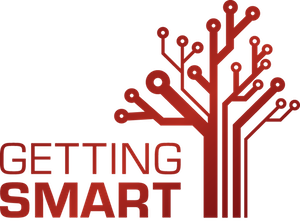 Sarah Cargill manages content and design for Getting Smart, the new blog and website created by education innovator and blended learning advocate Tom Vander Ark, a former state superintendent of education and education director for the Bill and Melinda Gates Foundation. Sarah’s areas of expertise include social media and public relations, with experience as a Social Media Specialist for Inspiration Software, Inc., the K-12 edtech company famous for its visual learning software.
Sarah Cargill manages content and design for Getting Smart, the new blog and website created by education innovator and blended learning advocate Tom Vander Ark, a former state superintendent of education and education director for the Bill and Melinda Gates Foundation. Sarah’s areas of expertise include social media and public relations, with experience as a Social Media Specialist for Inspiration Software, Inc., the K-12 edtech company famous for its visual learning software.
Among other work, Getting Smart is helping raise the voices of classroom teachers and school leaders (including several PLPeeps) who are champions of student-centered, technology infused teaching and learning. We asked Sarah to tell us more about Getting Smart, its content and goals, and the kinds of writing they’re interested in publishing from “smart teachers.”
1. When did Getting Smart launch and why should educators be interested in the content and activities at your website and blog? Who do you see as your audience?
We launched GettingSmart.com, formerly EdReformer.com, in August 2011. By making the shift from EdReformer to Getting Smart, we’ve moved toward a primary theme around innovations in learning.
Each week, we feature voices from the classroom with our Smart Teachers series, which seeks to inspire educators with new ideas, technologies, and practices teachers are incorporating into the traditional and online classroom.
We reach an audience comprised of education leaders, education policymakers, K-12 and higher education educators, administrators, education technology organizations, education associations, parents, and community members.
2. Tell us more about the book associated with the website, Getting Smart: How Digital Learning is Changing the World. What’s a “smart school” in Tom Vander Ark’s view? And when he writes about the need for schools to offer “personal digital learning opportunities” for students, what does he have in mind?
 Tom first began working on the ideas for his book Getting Smart years ago. While state superintendent in the early 90’s, he helped develop the first online high school in Washington State and stayed focused on education technology for the next decade. When you read the book and consider how revolutionary his ideas to advance learning through technology are today, you understand just how visionary he was nearly a decade ago.
Tom first began working on the ideas for his book Getting Smart years ago. While state superintendent in the early 90’s, he helped develop the first online high school in Washington State and stayed focused on education technology for the next decade. When you read the book and consider how revolutionary his ideas to advance learning through technology are today, you understand just how visionary he was nearly a decade ago.
Tom would describe a “smart school” as one that allows teachers and families to customize learning for every student. Using customization, motivation, and equalization techniques (as outlined in Getting Smart) every student has a unique, challenging, and rigorous learning experience that ensures college and career readiness. A smart school would adopt the Digital Learning Now! 10 Elements of High-Quality Digital Learning, leverage technologies to advance learning, and explore innovative ways to reach higher learning standards in efficient, student-centric ways.
When Tom discusses “personal digital learning opportunities” for students, he’s referring to the way that technological resources – many of which students are already bringing to school in their backpacks and pockets – can be utilized to open access to the idea economy, create customized lessons, motivate new learning, analyze individual student progress, and connect students to learning on a global scale. Many students use these tools outside of the classroom. It’s now time to welcome them into learning.
At the end of his book, Tom includes a Getting Smart Toolkit, which includes new ideas for BYOD policies, the introduction of AP courses online, ongoing professional development webinars, social learning online, and more. On our website, we’ve also compiled a great list of Q&A’s from his book.
3. Teachers and school leaders sometimes wonder if advocates of online and blended learning imagine a time when we won’t have physical schools. What’s your organization’s view?
We think schools will definitely look much different in the future. There will still be a segment of students who need to attend a physical school; however, they will be able to “blend” their school days. A full-time, online learning environment does work for many students and families. Yet, due to custodial issues, sports, band, and other activities, physical schools will likely still exist as learning management centers and meeting places.
We also believe that the education models found at Rocketship Education and Carpe Diem Schools deliver effective models blending online instruction and face-to-face time. In a rotation model students can enjoy working independently with technology, receive quality one-to-one time with an instructor, and collaborate with others for group work – all to the benefit of the students’ individual learning needs. So, while the dominance of virtual schools may be a future reality, we really support the models that blend online learning with in-person instruction.
The Getting Smart team works online daily from homes, coffee shops, conferences, and meetings across the country. We meet face-to-face monthly in person to run through major projects and attend conferences. We’ve found ways to adjust to working remotely by being active on email, text messages, phone calls, Skype chats, Google Hangout and more. Like online teachers and students, we all enjoy the increased flexibility of our office hours, location, and more.
4. What hats do you wear at Getting Smart?
At Getting Smart I’m a Project Manager and Contributing Editor. This gives me the opportunity to wear a few different hats. I get to work hands-on with the news and trends through my blog writing and the articles by our guest bloggers. I also work diligently on the technical side to improve the look and function of the site. With our Advocacy Partners, I help align overall communications, public relations, social media, and website efforts with an effective strategic plan.
5. How do you select your guest authors? What themes interest Getting Smart most?
On Getting Smart, we follow an editorial calendar as well as relevant news. We select guest authors based on experience, expertise, and the quality of writing as it relates to our editorial calendar and the hot news topics and trends.
We’re focused on a theme around innovations in learning across all ages (K-12, higher education, and lifelong learning). Most recently, we’ve been interested in the Common Core State Standards, BYOD policies, STEM education, open education resources (OER), apps for learning, gamification, and the post-textbook era.
6. What are some of your favorite guest posts at Getting Smart during the past year?
Jonathan Wai’s article “Why Don’t We Value Spatial Intelligence” was a big hit on Getting Smart. Adam Renfro always impresses me. He’s written great posts on the digital playlist, a mobile learning lab bus, and even a satire on The Hulk’s thoughts on education. Blogger Marie Bjered always makes me think! Her recent post “Math Wars: The Debate Between Higher-Order Vs. Rote Learning” takes a close look at how math education is evolving into higher-order thinking. I also really appreciated Kristen Swanson’s post reminding us of new, innovative ways to be social in a virtual school.
7. Several bloggers for PLP’s Voices from the Learning Revolution are guest-blogging at your website. How can other educators who think their writing might be a good fit for Getting Smart get in touch?
Educators who are interested in guest blogging for Getting Smart, may email me directly at sarah(at)gettingsmart(dot)com.
Thanks, Sarah. It’s a good opportunity for “shifted” teachers to share some of their story.
John Norton
Latest posts by John Norton (see all)
- I'm a "Learner First" in a Whole New World - July 1, 2013
- Hale@home: Easing Student Transitions via Online Learning - May 17, 2013
- Our Top 13 Voices Posts for 2012! - January 1, 2013


